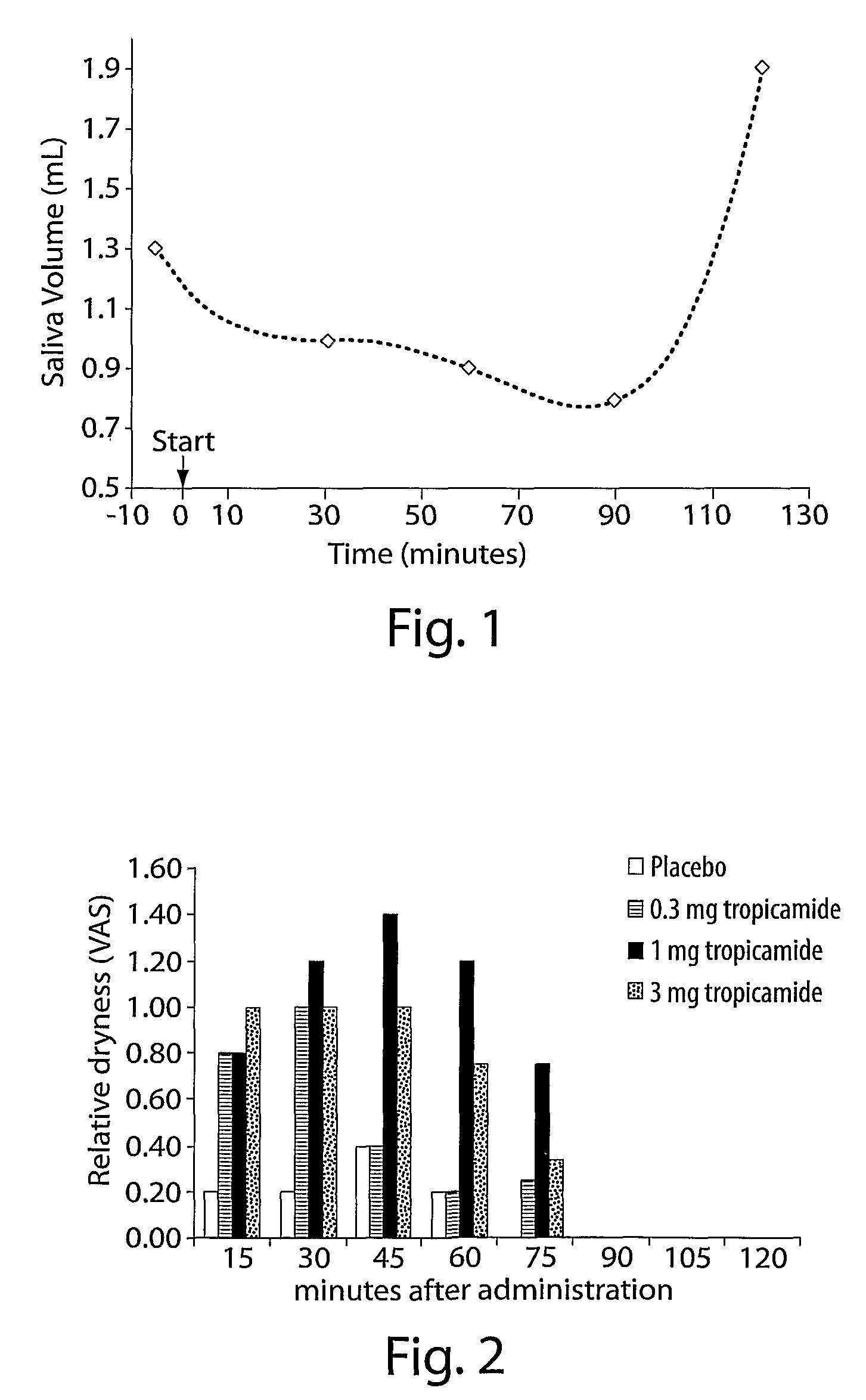Methods and compositions for decreasing saliva production
a technology of compositions and compositions, applied in the field of compositions and methods for decreasing the production of saliva, can solve the problems of social and medical disability, impaired speech, and unsatisfactory amounts of saliva in the mouth of individuals, and achieve the effect of reducing saliva production and controlling halitosis
- Summary
- Abstract
- Description
- Claims
- Application Information
AI Technical Summary
Benefits of technology
Problems solved by technology
Method used
Image
Examples
example 1
Pilot Clinical Study of Tropicamide Solution to Treat Sialorrhea in Parkinson's Disease Patients
[0104]In an open fashion, a group of four Parkinson's Disease (PD) patients (FLENI Institute, Argentina) complaining of sialorrhea were asked to administer a single dose consisting of 20 drops of Mydril® (1% tropicamide solution, Alcon) for a total of 10 mg tropicamide. Each milliliter (mL) contains 1% tropicamide with benzalkonium chloride 0.01% as preservative, sodium chloride, disodium EDTA and buffered to pH 4.0-5.8. The aim was to assess personal impression by the patients of their sialorrhea symptoms, including, drooling, speech performance, and social interference, as well as the presence of side effects, such as blurred vision, confusion, somnolence, tachycardia, hypotension, or any other discomforting sensation. The patients were evaluated for 2 hours in an outpatient clinic while resting in comfortable armchairs. They rated themselves on a visual analog scale by marking a line r...
example 2
Time Course of Saliva Production in Parkinson's Disease (PD) Patient Treated with Tropicamide Solution
[0107]One PD patient was treated with 20 drops of 1% tropicamide as in Example 1. Sialorrhea was assessed in the patient over time by the quantitative cotton plug assay method. In the cotton plug method for measuring the volume of saliva, three cotton plugs were placed in the mouth, two at the level of each Stenon duct and one on the floor of the mouth, for 5 minutes and then removed using sterile pincers to measure the volume of saliva. The plugs were placed into 15 milliliter (ml) graduated Falcon tubes and centrifuged for 5 minutes at 3000 rpm, and the volume of the fluid (saliva) measured. The results of the cotton plug assay are shown in Table 1, below.
[0108]
TABLE 1TimeVolumeVariationSample(min)(ml)(%)1−5.01.3100230.01.077360.00.969490.00.8625120.01.9146
[0109]The results, shown in Table 1, above, and as plotted in FIG. 1, demonstrate that a significant effect occurred relativel...
example 3
Long Term Treatment of Parkinson's Disease Patients with Tropicamide Solution
[0110]A group of Parkinson's Disease (PD) patients suffering from sialorrhea were instructed to use a 1% tropicamide solution on an out-patient basis to treat their excessive salivation. They were instructed to apply the drops to their tongues on an as needed basis. Two patients complained of the taste of the medication and discontinued use. Two patients reported that the treatment was useful and continued repeated use over a period of months.
PUM
| Property | Measurement | Unit |
|---|---|---|
| time | aaaaa | aaaaa |
| time | aaaaa | aaaaa |
| thickness | aaaaa | aaaaa |
Abstract
Description
Claims
Application Information
 Login to View More
Login to View More - R&D
- Intellectual Property
- Life Sciences
- Materials
- Tech Scout
- Unparalleled Data Quality
- Higher Quality Content
- 60% Fewer Hallucinations
Browse by: Latest US Patents, China's latest patents, Technical Efficacy Thesaurus, Application Domain, Technology Topic, Popular Technical Reports.
© 2025 PatSnap. All rights reserved.Legal|Privacy policy|Modern Slavery Act Transparency Statement|Sitemap|About US| Contact US: help@patsnap.com

